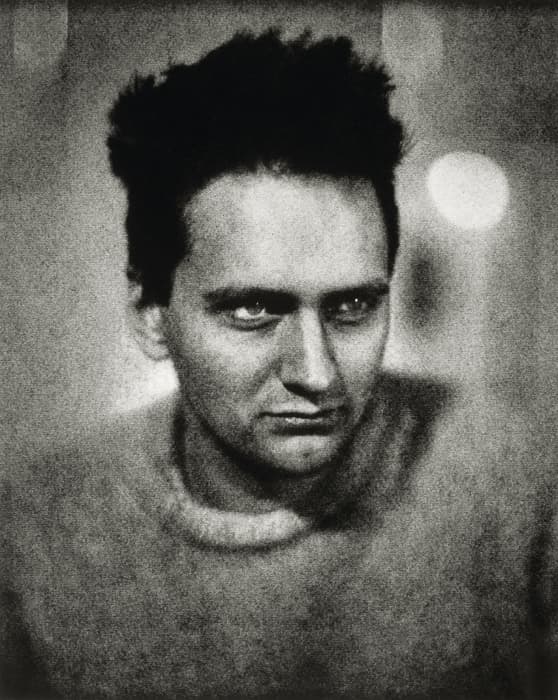Photo Insight with Andrew Sanderson

A renowned photographer, tutor, author and Ilford Master Printer, Andrew Sanderson offers practical tips on working with film and traditional darkroom techniques
This shot was taken in my studio a number of years ago. I used to hang around with a few friends there, many of whom were artists, musicians and photographers. We’d have a night down the pub and then retreat to the studio. It was a very creative and communal space, and it was on one of those nights that we all got together that this shot of my brother’s friend, Bob, took place.
The camera I used to shoot this image was a Thornton Pickard Junior Special, which feels like a wooden version of a Mamiya RB67. It has rack-and-pinion focusing, much like the RB67 does, and it also has a rotating back for both horizontal and vertical compositions. Most interestingly, it has a focal-plane shutter that you have to wind up that goes off with quite a noise. It’s a nicely designed camera, one that was made in Manchester, if I recall. I used to use it quite a lot for portraiture because it had such a nice quality to it. I’d use it with Ilford HP5 film and also managed to adapt it so I could put Polaroid sheet-film into it. And, most relevantly, I was able to use it to produce paper negatives.
The lens was a Kodak Aero-Ektar, a 178mm optic that has gone down in legend. It was originally designed for aerial photography so that the images could be used to produce maps. They were made with a maximum aperture of f/2.5. It’s actually rumoured that the back element of the lens is radioactive because they treated the glass in a certain way to improve light transmission. I’m no scientist, so you’ll have to investigate that one yourself. Regardless of the implications on one’s health, the lens has a beautiful quality and is very similar to the kinds of lenses that the Hollywood photographers used to use. So the Ektar really suited portraiture, but it was actually only designed to cover 7in [18cm] square, which makes it perfect for the 6×7 format.

This shot is actually a paper negative (see AP 26 May for more on how to produce paper negatives), and the paper I used was Kentmere fibre-based paper. You can’t actually get that particular type any more. It was a very thin paper, a kind of matt parchment drawing paper, and was excellent for producing paper negatives. It had a texture that was unique to that brand. When you print from paper negatives the texture of the paper becomes part of the image. That’s what gives it the look – it appears almost as if it has been printed on linen. I still have some old rolls of it kicking around, but it doesn’t perform in quite the same way as it has lost a lot of its contrast, which is a real shame.
The speed of this paper – it works on the same principle as film speed – is ISO 1.5. Some people will set their camera for ISO 3 or even 6, but that will give you a very contrasty print, which will remove all details in the shadows. I prefer to retain a bit of information in the lowlights. Some papers can be very slow, such as Forte. Alternatively, if you’re working with multigrade paper, then the speed is generally ISO 4.
On a technical level, this was a very simple shot to produce. It was done using two tungsten floodlights, one fairly large 1,000W lamp, which was quite close to the subject’s face, and then another smaller-wattage one to act as a fill-light (you can just about make it out in the picture frame in the background). The fact that I’m shooting using such a low ISO means that I’m going to have to ensure that the light and exposure compensate for that. With that in mind, the light had to be quite strong. I don’t have a record of the exposure, but I do know that the aperture was fixed at f/2.5 allowing for a relatively fast shutter speed. With that strength of lamp I can imagine that it was probably 1-1.5secs.
It was only after I took the shot that people started making the comparisons to how Jack Nance looked on the promotional posters of David Lynch’s 1977 film Eraserhead. It was not my intention to copy that image, but there are definitely similarities. There’s also a famous image by the photographer Yousuf Karsh of Ernest Hemingway wearing a big jumper that it also shares some parallels with. Others have even said he looks a bit like Spike Milligan. Personally, I think he looks like Bob.

If you would like to read more about paper negatives, Andrew’s book Paper Negative Photography is available from www.blurb.com, price £15
Andrew Sanderson was talking to Oliver Atwell








